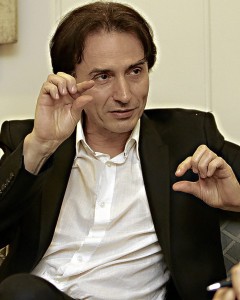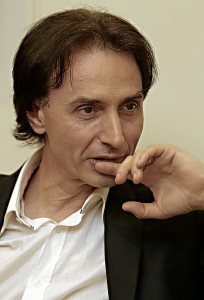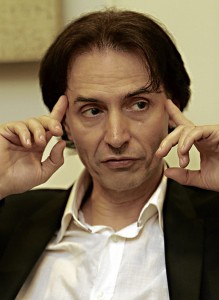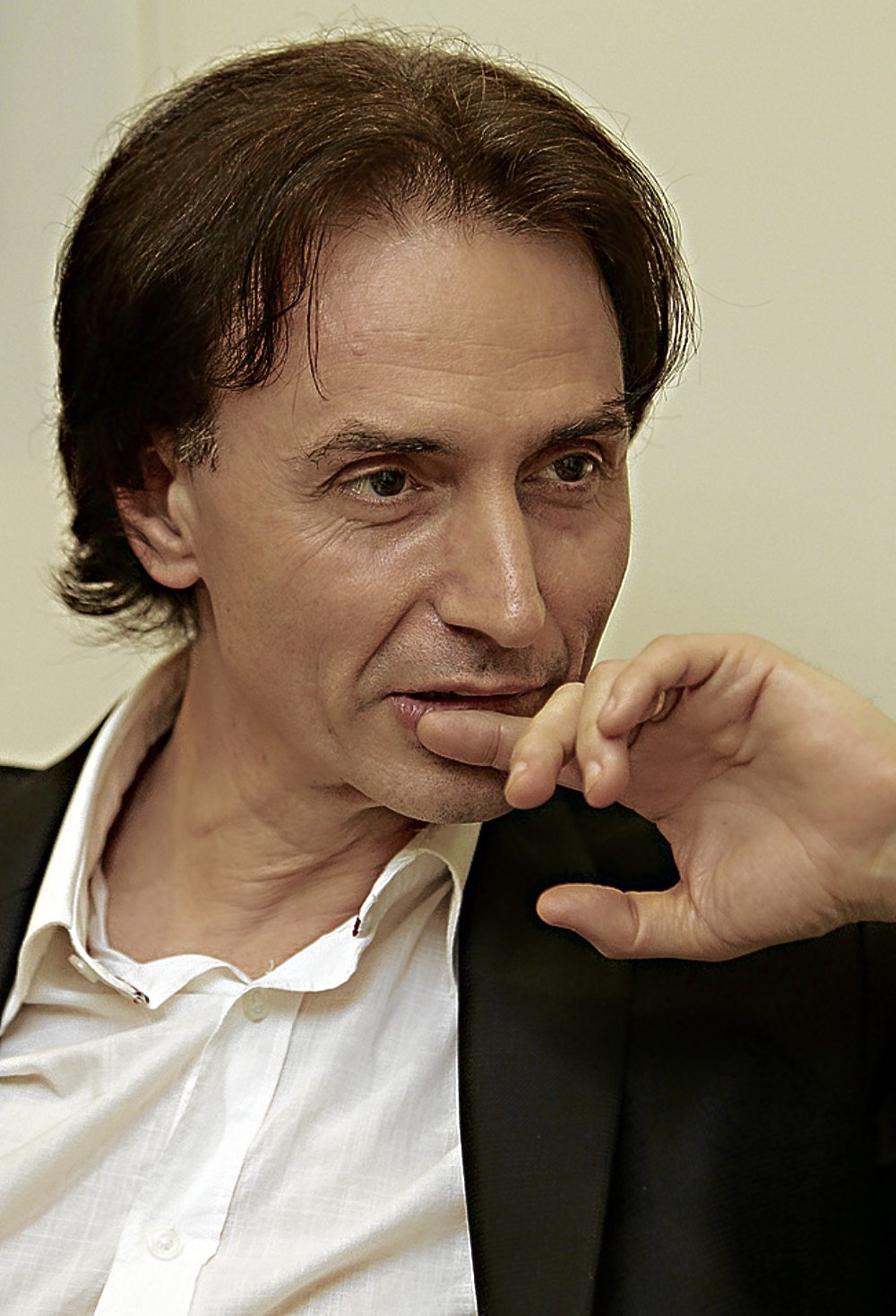
On the weekend of March 24, Manila theater goers were taken by pleasant surprise with the twin bill performances of Barcelona’s Ballet David Campos’ “Sleeping Beauty” and “Giselle.”
A relatively unknown dance company, save for a few dance cognoscenti who knew of Sr. Campos’ partnership with his wife, Filipina ballerina Irene Sabas, former principal dancer of Felicitas “Tita” Radaic’s Dance Theater Philippines until her departure for the Royal Ballet of Flanders sometime in the ’80s, the reinterpretation of the two classic ballet pieces that combined high technology, and modern and classical choreography, coupled with a twist in the traditional story line, lent a much needed shot in the arm to the local dance scene.
Both ballets are set in contemporary contexts.
“Sleeping Beauty” is treated as a story within a story, springing from Sr. Campos’ conceptual query: “What happens to Princess Aurora who fell asleep under a spell?” The answer is, the years pass and move into the present, where the sleeping princess is found still asleep in the woods, is brought under modern-day scans and lasers, to no avail. A doctor brings her to his home where she is indeed awakened by the enamored doctor’s kiss, in the production’s momentous gem that successfully mixes live action supported by computerized visuals, with pleasant Almodovar-esque insanity ala “Talk to Her.”
Now awake but in the present day (which is the future for the princess), the doctor brings the princess to watch a ballet, which coincidentally depicts the story of her own life. Dazed and confused, she jumps back into her own story in the past where she finds her equilibrium and continuity, the doctor now transformed into her prince charming.
While “Sleeping Beauty” maintained its fairy tale-like component, Sr. Campos’ “Giselle” was dark and eerie, with much more dance time than “Sleeping Beauty.” Campos prefaces his tale with the myth of young girls who have died of broken hearts, transformed into water nymphs who dance men to death. What Campos reveals later is what these spirits do to the men they drive to their deaths. Compressed into a mere hour and a half, with no intermission between acts, “Giselle” opens in a punk bar. Giselle, an awkward Betty La Fea clone manages to charm Albrecht, and on their walk home, gets raped and mugged as Albrecht abandons her. He later returns to the scene only to find her breathing her last. In an attempt to make her live, he brings her to a hospital emergency room. Here, a techie-heaven’s death scene is played out where a scrim ripples in
 Escher-like geometrics as a Giselle in death throes touches it. On the proscenium, the life line is projected until it reaches its dramatic flatline. It is a multi-media sensoried layering of life clinging dancing mid-stage, technology in between, and live action drama of Albrecht’s grief upstage.
Escher-like geometrics as a Giselle in death throes touches it. On the proscenium, the life line is projected until it reaches its dramatic flatline. It is a multi-media sensoried layering of life clinging dancing mid-stage, technology in between, and live action drama of Albrecht’s grief upstage.
Perhaps among the most recognizable of ballet staples is “Giselle’s” Act 2, with those expressionless Willis fleeting by, and a surreal pas de deux with human male and ethereal female. No such thing in this one. Instead, the Willis are depicted as vicious man-eating cannibals in ripped tutus with bad hair days. In the opening forest scene, a man is walking through. Then in the vein of fright night movies, Campos makes Willis momentarily pop up and fade away in hazy light like spectral apparitions in various parts of the stage.
Here, judging from audience reactions, Campos thoroughly succeeds in establishing the scare factor. The rest of the story proceeds as in the original, but with Campos’ neoclassical choreography. He adds a sentimental, soft, heart wrenching denouement of an aged Albrecht making a floral offering, touching the water where
Giselle’s hauntingly pained face is superimposed… all on computer generated film.
Although this kind of retelling of the classics has been a trend that has been ongoing in global dance theater, it was the first time that Manila had experienced a performance right at home. A conversation with David Campos reveals the man behind the sagas, and then some:
Is this the kind of trend going on in Europe and the rest of the world? Like Matthew Bourne, for example…“Swan Lake”… and Mark Morris…
He’s American.
Are choreographers bored with the classics?
 No, I think it’s an evolution. What I did was to play with the two worlds. I will put the classic and the modern to show that the dancers can still dance a piece that is very very strictly classical… it’s a ballet, and our (company’s) stamp is classic. I think its justified… this little bubble in a new world… little bubble of the classics. It’s a new approach.
No, I think it’s an evolution. What I did was to play with the two worlds. I will put the classic and the modern to show that the dancers can still dance a piece that is very very strictly classical… it’s a ballet, and our (company’s) stamp is classic. I think its justified… this little bubble in a new world… little bubble of the classics. It’s a new approach.
It is very enjoyable, and I think a lot of people in the audience enjoyed it a lot. The marriage of technology and the classics lends itself to a bigger audience.
Do you think it becomes more appealing to the younger generation?
Yes, I think so, because now, not like before, we cannot present the original version of “Giselle” or “Sleeping Beauty” that children in general will enjoy. Why? It is too long, so many moments nothing happens. I think there is something unbalanced. The new generation, they are used to something fast, they understand things very quickly, they don’t need instructions, so we have to adapt ballet. If we lose the interest of the children, then it is finished.
Is this the reason why there were some sections where you simplified it, or shortened sequences, made it more dramatic, more theatrical, or even funny… like in the scene where the princess wakes up… it was almost Almodovar-insane.
(Laughs) Yes, there are many topics in the ballet that will look funny today… the cats [a divertissement in “Sleeping Beauty,”] for example. It is very hard to understand a suite of different roles in the middle of the ballet. At that time before they did it to make the ballet a little longer, even if it had nothing to do with “Sleeping Beauty.”
And to showcase the soloist?
Exactly, exactly! So we were following the tradition, not knowing that for example, Tchaikovsky was very sad [composing] “Nutcracker,” which I think is one of his best. He was at first very happy to do a new piece of music. Very inspired! But at that time, the government, the Czar, pushed him to do a specific piece of music, a divertissement to show off the ballerina. So he made it his will to make something good, just to follow [the Czar’s] rule or imposition. Now, I think, with all due respect, we can change some things. Nothing should be like before. This is the time where we can use the essence [of the classics] to make our own version… like architecture, you maintain the base, but we break the lines, we play with the gravity. So I think I’m doing more or less the same, but on the condition that the company is the company of today. Today, there is not so much money. Europe is suffering a lot. Spain is going to break down, so we cannot dream of having a company of 40 dancers, 50 dancers to make the classics how they did before… so we have to find ways to maintain this interest, to maintain this technique, to maintain this quality, and to approach the new generation with the ballet.
When you deconstruct the story, how much of the original do you leave behind? In Sleeping Beauty I noticed you left the original Petipa Aurora pas de deux and the
Bluebird pas de deux. Why did you do that?
It’s because it has become a true classic. We like to see it.
You are a story teller and a conceptualist. I want to know your process… how your mind works. Is it the choreography first or the video?
I think it’s the music… then the person. I get inspired by the person… by the girl, Elline (Damian).
Elline?
Yes, Elline. It’s the first time we are using a big projection, and we come in very close, so we need to project the beauty of the dancer… because in the world there are many ballerinas with high standards, but not always beauty.
So when you start the actual work, after the music, do you choreograph first, or do you shoot the video?
At the same time. It’s a process like there’s a flower, then there is a fruit… and during the process, I make changes.
Doesn’t your videographer go crazy?
We work together. He’s not alone. Also the composer. I like to work with young people. They are different from our generation (Laughter). They are more (into) technology, they are faster, they have a universe of material, they have the Internet… and they know faster ways to get this picture, this music….
For example, when the fairy waves her hand, you see stars on the video.
It’s the whole concept. It’s the balance between the dancer, what you want to say, and the support of the effect.
There are some choreographers who do well in short pieces. But there are some who have a problem with narrative.
Choreography is emotional. (It is) the ability to find words, images in the music, because for me the music tells me what… I imagine the moment. If I’m lucky, I share that moment with the dancers. That’s why I don’t do music independent from dance. The art should always be going back… it should be free… play with the natural emotions of the human being. For me, what is good is that the audience understands what I’m trying to say. William Forsythe has the incredible concept of movement—it’s beautiful! But it’s always like that. Balanchine has a hard time to make stories. So for me, these choreographers are always dependent on the intellectuality of the music. Me not, I depend on the emotion of the music. Sometimes I don’t even need to count… sometimes it depends on the instrument… a guitar… a cello… Choreography is like a person… you should accept the capacity… otherwise you lose that something that is unique. I just keep on doing.
I noticed that some of your female dancers are well-endowed, which is unusual for ballerinas. And your prince was a bit hefty.
There is something human. Why should a ballerina be thin? She should be able to interpret, she should be able to perform. There are so many other things aside from being just fat or thin. The prince… he also did Carabosse. He is a fantastic dancer… he was… but he got into a big crisis. We are helping him. To get somebody with his quality from the Royal Ballet would be very expensive. But he’s there. We try to help him and maybe he doesn’t have now the shape, but the potential as an actor… he looks mature. So it’s not perfection, but there’s this human side. If they’re not perfect, you have to find a way to use them.
How does your work stand up in Barcelona?
In Barcelona, there are about 42 companies, all contemporary. We are the only one classical. And the government, they never wanted to support us because of the pointe shoes. They were against classical.
Why so?
In the ’80s, the government decided that Spain had to be avant garde, progressive, and to cut the recognition of flamenco. And they said, in dance, we will support anything that is a new idea. There are hundreds of dance companies in the whole of Spain, but classical, they will never give money. I think it was a big error because now in Spain, one goes to the ballet. Theaters are empty. Our style is to find a way to convince them that it is worth it. Our shows in Spain are full.
I read in a blog that your company was in danger of losing the grant you had in the theater, Teatre Sagarra de Santa Coloma de Gramenet.
We had a residence in that theater in a city just outside Barcelona. It was the mayor who saw the company. It was a city like Brooklyn. It had many immigrants like Africans. There were many children, and the mayor wanted the children to go into the arts… music, ballet, theater. He said, “I want the classics because we have no competition.” So he gave us the theater… a very very nice modern theater. It was a pity, sometime in 2004, the mayor did something wrong and he went to prison, and he was the one supporting the company. And when he left, they didn’t want to support the company. We had no more theater, no more money.
So how are you surviving?
We have a studio. That’s the base, that’s the mother. Even (when) we were residents in the theater, we maintained our school. We rehearse in our studio. That’s where the company grows. Sometimes in Barcelona we are performing everyday, sometimes 2, 3, 4, 5 weeks everyday, except Monday. You’ll be surprised… I spend maybe 10% on the artistic side. Irene and I are always going up and down looking for money, performing, marketing, designing. If you look at the company, it looks like a rich company, getting big support from the government. But we get very little. We just have 10 dancers.
On the personal side, your daughter dances beautifully. What plans do you have for her?
She has her own life. When you have a daughter going with you, the mother is a director, the father is a director, I think it’s very hard for her. Already we are lucky that she likes to dance. Most children who have parents who dance, don’t want to dance. It’s too much, it’s too much! And we bring the work at home. It’s 24 hours.









































